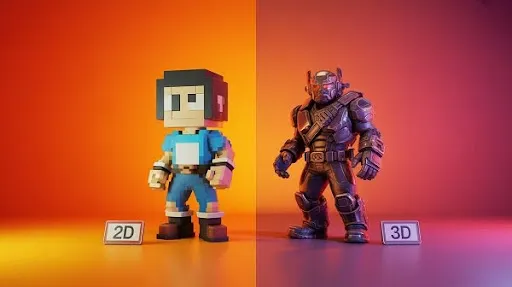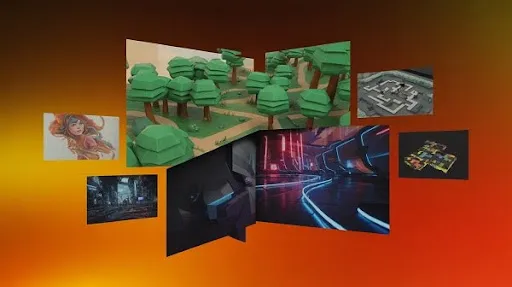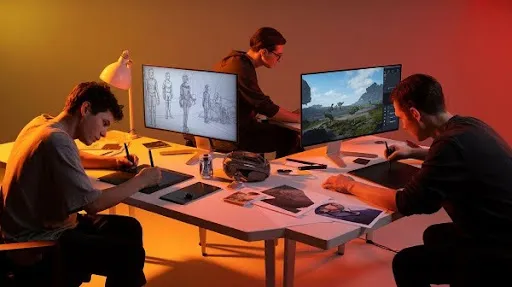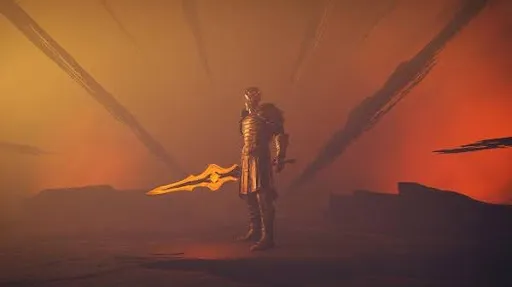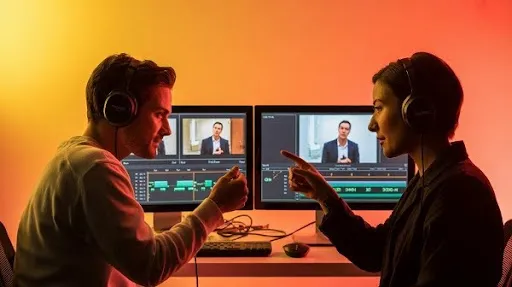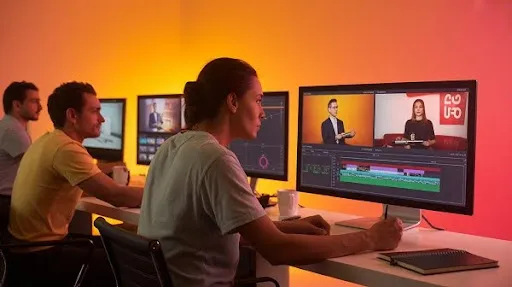When players watch a game for the first time, what grabs their attention? Not the dialogue. Not the combat system. It’s the art. The way a game looks decides if someone leans in or switches off before the opening cutscene even ends.
Game art styles aren’t a side detail—they’re the heartbeat of how players connect. The tone, the atmosphere, the emotional weight of every scene—it all comes through visuals.
Even the strongest mechanics can fall flat if the art feels out of place. On the flip side, the right look can make a simple idea feel unforgettable.
That’s why different game art styles matter so much. They’re not just “pretty skins.” They shape how a project feels, how it’s remembered, and sometimes, how well it sells.
Why Picking Game Art Styles Is Complicated
It sounds easy, right? Just pick a look you like. But ask any serious developer and they’ll tell you—it’s a balancing act between creativity, budget, and strategy.
Studios don’t just ask “what looks good?” They ask, “what can we afford, what matches our core gameplay mechanics, and how will our players react?” That’s where things get messy.
Small teams often lean into 2D game art styles because they’re less resource-heavy. Still, even a game with geometric art style—something that looks “basic” at first glance—needs careful execution.
AAA developers, meanwhile, might chase 3D game art design with cinematic graphics. But that takes huge pipelines, specialists, and months (if not years) of polishing.
The real struggle? Finding an art style that doesn’t just catch attention but also strengthens the game underneath.
Key Factors Before Deciding on an Art Style
1. Budget and Resources
Your wallet sets the rules. A 3D art game’s graphics can look mind-blowing, but they come with long schedules, big teams, and expensive tools. By contrast, 2D art game’s graphics might be easier on costs, but they demand more creativity to stand out.
2. The Nature of Gameplay
The pace of your project should influence its visuals. A fast-paced action game can’t afford clutter—you need clear visuals so players can react instantly. Slower, story-heavy games benefit from atmospheric designs that pull players deeper into the narrative.
3. Audience Expectations
Your players already have preferences. Retro fans eat up pixel art. Younger audiences lean toward cartoonish or realistic graphics. Meeting those expectations early builds trust and keeps people engaged.
4. Technical Boundaries
Every platform has limits. Mobile can’t handle the same heavy rendering as consoles or PC. That’s where an experienced game art studio helps—they know how to balance ambition with what’s actually possible.
5. Branding and Market Differentiation
Think of art as branding. A hyper-realistic trailer screams cinematic quality and builds hype. A quirky, stylized look might help you cut through a crowded market. The style you pick shapes how people remember your game.
6. Emotional Resonance
Visuals don’t just “look cool.” They create feelings. Dark tones set suspense. Bright palettes build joy. The chosen art style defines the emotional punch your game delivers.
Breaking Down 3D Game Art Design
3D game art design rules much of today’s industry, but not every 3D look is the same. Developers experiment with a range of directions, and each one has its own trade-offs.
Realism in 3D
This style aims to copy life as closely as possible. Games like Red Dead Redemption 2 or Uncharted 4 blur the line between film and interactive media. Every texture, shadow, and detail is polished. The downside? It eats up time, budget, and demands elite 3D animation services.
Fantasy Realism
What if realism met imagination? That’s the sweet spot of fantasy realism. Think The Witcher 3, Skyrim, or Cyberpunk 2077. Dragons and futuristic cities feel believable because they’re wrapped in lifelike detail. It’s immersive and thrilling, but it takes a team skilled in both realism and creativity.
Low Poly 3D
At the opposite end sits low poly. Clean shapes, minimal textures, and striking simplicity. Monument Valley showed how powerful this can be—minimal yet iconic. But it’s not “easy.” Without strong direction, low poly risks look unfinished instead of stylish.
Hand-Painted 3D
Textures that look like brushstrokes. Memories Retold is a prime example, where the visuals feel like stepping inside a painting. It’s niche, yes, but for story-driven projects, it creates unforgettable emotion.
Cartoon 3D
Bright, exaggerated, full of life—cartoon 3D is everywhere. Overwatch and Fortnite prove how fun and accessible this style can be. It appeals broadly, though developers need to keep things readable amidst all the playful chaos.
Exploring 2D Game Art Styles
2D video animation hasn’t lost its charm. In fact, many developers still lean on it for its flexibility and timeless feel. 2D art game’s graphics can be bold, nostalgic, or playful—and they come in plenty of flavors.
Fact: The 2D gaming market was estimated to be around USD 200 billion in 2024 and is expected to reach USD 300 billion by 2033, exhibiting a compound annual growth rate (CAGR) of 5.5%.
Flat Art
Simple, stylish, and easy to read. Flat art uses clean shapes and bold colors. Monument Valley again is a showcase for how this can be visually stunning without clutter. Still, it takes a sharp eye for design to keep it engaging.
Vector Art
Vectors never lose their crispness. Scale them up, shrink them down—they stay sharp. That’s why vector graphics thrive in mobile and cross-platform games. From BattleZone to The Banner Saga, vectors have proven their staying power.
Geometric Art Style
In a game with a geometric art style, the visuals revolve around basic shapes. Thomas Was Alone nailed this approach by turning rectangles into emotional storytelling devices. It’s simple, yes, but harder to pull off well than it looks.
Pixel Art
Pixel art is nostalgia bottled up. Stardew Valley and Hotline Miami thrive on this retro charm. It’s affordable compared to realism and immediately resonates with players who grew up in the 80s or 90s.
Cartoon 2D
Cartoon visuals in 2D pack the same punch as in 3D. Bold colors, fun exaggeration, and humor make them accessible. Team Fortress 2 is a perfect example of this vibe.
Cel Shading
Cel shading adds a hand-drawn comic look to 3D assets. Zelda: Wind Waker remains the classic case. Done right, it delivers a striking, unique identity. The challenge is in managing lighting so it doesn’t break the illusion.
Monochromatic Styles
One color palette, endless mood. Limbo and Inside rely on shades of black, white, and gray to create eerie, emotional experiences. Limited, yes, but incredibly effective when used with purpose.
Why Studios Turn to Game Art Outsourcing
No studio can master every single style. That’s where game art outsourcing steps in. Partnering with an experienced game art studio like Prolific Studio gives developers:
- Access to 2D video animation and 3D animation services.
- Relief for overworked internal teams.
- A chance to test different looks before locking one down.
Outsourcing frees up time so studios can zero in on core gameplay mechanics while experts handle visuals.
The Power of Game Trailers
Game Trailers are your first handshake with players. They set expectations instantly. A polished teaser with a hyper-realistic trailer can give even a small project blockbuster energy. More than just ads, trailers are storytelling tools. They showcase your chosen art style, stir emotions, and build hype long before launch day.
Advanced Perspectives on Game Art Styles
So far, we’ve skimmed the surface—pixel art, realism, cel-shading, all those usual suspects. But knowing the terms doesn’t mean you really get how they’re used. The real juice is in how developers twist these styles into something that makes players feel a certain way.
Art direction isn’t a skin you slap on at the end. It’s alive. It bends with tech, with trends, and sometimes it even throws a curveball no one saw coming.
So instead of boxing styles into neat definitions, let’s look at how they evolve, how they mess with psychology, and why bending the rules often beats following them.
Evolving Trends in Game Art Styles
Fire up a game from 2010. Chances are, some of it looks clunky now. That’s how quickly taste shifts. What blew minds back then can feel dated today. Oddly enough, though, older looks—like pixel art—keep boomeranging back. Not as straight copies, but with fresh twists.
A good example? Hybrid design. Square Enix’s Octopath Traveler pulled it off—sprite characters dropped into lush, 3D dioramas. Nostalgia with modern flair.
Then there’s stylized realism. Not hyper-detailed to the point of creepiness, but not flatly cartoonish either. It’s the sweet spot where worlds feel believable without veering into uncanny territory. Works like magic in fantasy and sci-fi.
And don’t forget the tech side. Procedural generation and AI-driven tools now let smaller teams punch above their weight. You’re not hand-placing every pebble anymore—tools do the grunt work, freeing artists to polish the stuff players actually notice.
One more trend worth shouting about: accessibility. Devs aren’t just making games “pretty” anymore. They’re thinking about colorblind filters, readability, and visual clarity so more players can enjoy the experience. Looks mean nothing if half your audience can’t follow what’s happening on screen.
The Psychology Behind Game Art
Game visuals are sneaky. They don’t just sit there looking nice—they shape how we react without us even realizing.
Colors? Huge deal. Bright neons pump energy into a platformer. Dark greys and sickly greens? Suddenly you’re tense, bracing for horror.
Shapes, too: round, soft characters come across as friendly. Spiky, jagged designs instantly feel threatening.
Animation seals it. Exaggerated squash-and-stretch turns a character into someone you want to hug. Weighty, realistic motion sells drama or grit.
The one rule studios live by: keep it consistent. A mismatch—say, photoreal humans plopped into a cartoony world—jolts players right out of immersion. Unless done intentionally, it’s risky business. That’s why teams sometimes spend months just locking down their art “language” before actual production even kicks in.
When to Experiment With Style
Here’s the eternal fork in the road: play safe or swing big.
Indie teams often lean toward pixel art or low poly. It’s cost-friendly, quick to produce, and players already have a soft spot for it. Safe doesn’t have to mean boring—some of the most beloved indies doubled down on these styles.
Larger studios? They’ve got room to gamble. Borderlands made cel-shading its signature, and Journey stripped everything back to minimalist abstraction. Risks, yes, but they paid off.
Of course, there’s the “in-between” approach. Take something familiar and sneak in a twist. A little quirk, a signature detail. That tiny shift can make the game stand out without alienating players.
Why Work With Game Art Studios?
A lot of people think outsourcing = saving money. Not the full story.
Specialized art studios bring a perspective you might miss in-house. They scale up production when you’re slammed, without you needing to hire a small army. Some focus on very niche areas—props, characters, animation—so you’re tapping into deep expertise, not just extra hands.
And here’s the kicker: they can unify everything, from in-game assets to promo trailers. That consistent “look” across every channel? Gold in a crowded marketplace. Players notice.
Case Studies
Easier to show than tell. Here are a few games where style wasn’t just decoration—it defined the experience:
- Hollow Knight – Hand-drawn visuals gave the Metroidvania a haunting, fairytale quality.
- Fortnite – Bright, cartoonish graphics turned what could’ve been another shooter into a cultural juggernaut.
- Inside – Minimal color, almost monochrome. That alone made the game feel eerie without a single line of dialogue.
- The Witcher 3 – Realism mixed with fantasy design created one of the richest open worlds ever.
Different genres, different looks, but the same takeaway: style doesn’t have a “best.” It’s about what fits.
Frequently Asked Questions
Which art style is cheapest to develop?
Usually pixel or low poly. But cheap doesn’t mean easy—bad pixel art is obvious.
Can you really mix 2D and 3D in one project?
Absolutely. More teams are trying it. The trick is cohesion—make them feel like they belong in the same world.
Do realistic graphics always sell better?
Nope. If they did, Minecraft wouldn’t be dominating charts.
How big of a deal are trailers for showing off style?
Massive. For most players, that’s the first handshake with your game. If your art shines there, you’re already ahead.
Should indie teams aim for AAA realism?
Almost never. Without huge budgets, realism becomes a trap. Stylized art often works better and lingers longer in players’ minds.
Final Word
Game art isn’t frosting—it’s part of the cake. It sets the mood, tells stories, and shapes what sticks with players years later.
Pixel charm, stylized realism, even hybrids—whatever you choose, it has to sync with your mechanics and your audience. The studios that nail that alignment? Those are the games we don’t forget.
At the end of the day, style is memory. It’s the reason people come back. If you want killer game art styles for your next project, then get in touch with us, as we are one of the best animation studios in Florida to deliver beyond what you expect.
Related Articles:

